前言
在前端框架Angular中,组件之间的通信很基础也很重要,不同组件间的通信方式也不同,掌握组件间的通信方式会更加深刻的理解和使用Angular框架。

本文讲解不同类型组件间的不同通信方式,文中所有示例均提供源码,您可以 在线编辑预览 或 下载本地调试,相信通过本文您一定可以掌握组件通信这一知识点。
父组件传子组件
@Input方式
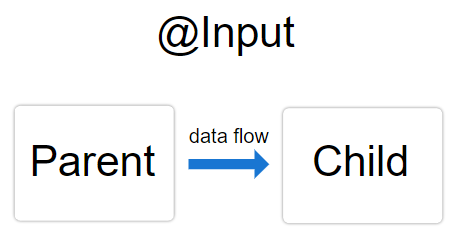
@Input()装饰器允许父组件更新子组件中的数据,分为4步:
第一步:在父组件app.component.ts中定义要传递给子组件的数据parentMsg。
export class AppComponent {
parentMsg: string = 'parent component message!';
}
第二步:在父组件app.component.html中的子组件标签<app-child>中定义属性[childMsg](子组件接收数据变量)来绑定父组件的数据parentMsg。
<app-child [childMsg]="parentMsg"></app-child>
第三步:在子组件child.component.ts中引入@Input()装饰器,修饰childMsg接收父组件的传值。
import { Input } from '@angular/core';
export class ChildComponent {
@Input() childMsg: string = '';
}
第四步:在子组件child.component.html中通过模板标签{{childMsg}}展示数据。
<div>父组件传值内容:{{ childMsg }}</div>
最终展示效果如下,您可以通过 在线示例 预览效果和编辑调试:

说明:这里要理解父组件html中通过[]定义了一个子组件的属性,该值必须与子组件中所定义的变量名一致,而等号右边的值为父组件要传递的属性名,示例中是将父组件中parentMsg的值绑定在子组件childMsg属性上。
子组件传父组件
@Output()方式
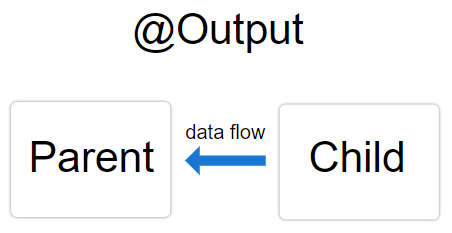
@Output()装饰器允许数据从子组件传给父组件,分为6步:
第一步:在子组件child.component.ts中引入Output和EventEmitter,通过@Output()来修饰一个EventEmitter实例的变量newItemEvent。
import { Component, Output, EventEmitter } from '@angular/core';
export class ChildComponent {
@Output() newItemEvent = new EventEmitter<string>();
}
第二步:在子组件child.component.html中添加点击事件,获取输入内容,点击按钮触发addNewItem()方法。
<label>输入项目名:<input type="text" #newItem /></label>
<button type="button" (click)="addNewItem(newItem.value)">
添加项目到父组件
</button>
第三步:在子组件child.component.ts中通过newItemEvent的emit()方法,把数据发送到父组件。
export class ChildComponent {
@Output() newItemEvent = new EventEmitter<string>();
addNewItem(value: string) {
this.newItemEvent.emit(value);
}
}
第四步:在父组件app.component.html中子组件标签<app-child>中添加父组件方法addItem($event)绑定到子组件的newItemEvent发射器事件上,其中$event为子组件的传递的值。
<app-child (newItemEvent)="addItem($event)"></app-child>
第五步:在父组件app.component.ts中通过addItem($event)方法获取处理数据。
export class AppComponent implements AfterViewInit {
items = ['item1', 'item2', 'item3'];
addItem(newItem: string) {
this.items.push(newItem);
}
}
第六步:在父组件app.component.html中遍历items展示数据。
<ul>
<li *ngFor="let item of items">{{ item }}</li>
</ul>
最终展示效果如下,您可以通过 在线示例 预览效果和编辑调试:
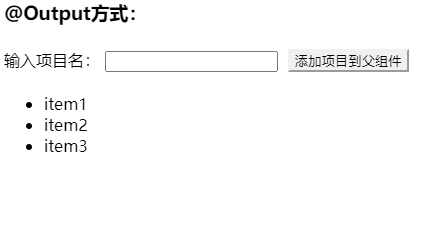
说明:这里要理解关键的第四步事件连接(newItemEvent)="addItem($event)"含义,左侧是父组件监听子组件创建的一个发射器newItemEvent,右侧是父组件的addItem($event)方法。子组件通过发射器的emit(value)方法广播传递值到父组件,父组件通过addItem($event)中的$event接收传值,完成通信。
本地变量方式
在父组件模板里,新建一个本地变量来代表子组件,可以利用这个变量来读取子组件的属性和调用子组件的方法。分为2步:
第一步:在子组件child.component.ts中定义count变量和addOne()方法。
export class ChildComponent {
count: number = 0;
addOne() {
this.count++;
}
}
第二步:在父组件app.component.html中子组件标签<app-child>中添加本地变量#child,点击按钮触发点击事件,通过本地变量调用子组件方法child.addOne()。
<app-child #child></app-child>
<button type="button" (click)="child.addOne()">加1</button>
最终展示效果如下,您可以通过 在线示例 预览效果和编辑调试:

说明:在子组件标签中通过#+变量名的方式新建一个本地变量代表子组件的引用。本地变量方式使用简单明了,但也有局限性,只能在模板html中使用,无法在ts文件中使用。
@ViewChild方式
通过@ViewChild装饰器,将子组件注入到父组件。分为4步:
第一步:在子组件child.component.ts中定义count变量和add()方法。
export class ChildComponent {
count: number = 0;
add(num: number) {
this.count = this.count + num;
}
}
第二步:在父组件app.component.html中子组件标签<app-child>中添加标签引用#child,点击按钮触发点击事件,执行方法add()。
<app-child #child></app-child>
<button type="button" (click)="add(2)">加2</button>
第三步:在父组件app.component.ts中引入ViewChild,@viewchild传入标签引用字符child,由变量child接收。除了使用标签引用child,你也可以通过直接传入子组件ChildComponent实现子组件的引用。
import { Component, ViewChild } from '@angular/core';
import { ChildComponent } from './child/child.component';
export class AppComponent {
// 第一种方法:传入组件引用名child
@ViewChild('child') private child: any;
// 第二种方法:传入组件实例ChildComponent
@ViewChild(ChildComponent) private child: ChildComponent;
}
第四步:在父组件app.component.ts中方法add()中调用子组件的add()方法。
export class AppComponent {
add(num: number) {
this.child.add(num);
}
}
最终展示效果如下,您可以通过 在线示例 预览效果和编辑调试:

说明:@ViewChild的作用是声明对子组件元素的实例引用,意思是通过注入的方式将子组件注入到@ViewChild容器中,你可以想象成依赖注入的方式注入,只不过@ViewChild不能在构造器constructor中注入,因为@ViewChild()会在ngAfterViewInit()回调函数之前执行,我们可以测试下:
import { Component, ViewChild, AfterViewInit } from '@angular/core';
import { ChildComponent } from './child/child.component';
export class AppComponent implements AfterViewInit {
@ViewChild('child') private child: any;
constructor() {
console.log('constructor func', this.child); // undefined
}
ngAfterViewInit() {
console.log('ngAfterViewInit func', this.child);
}
}
最终展示效果如下,您可以通过 在线示例 预览效果和编辑调试:

通过打印结果我们可以看到在构造函数constructor()中,this.child的值为undefined,并没有注入到父组件,但在ngAfterViewInit()生命周期钩子中注入成功了。
不相关组件
对于不相关联的组件,我们会使用其他中间媒介的方式进行通信,以下不相关组件的通信方式仍适用于父子组件。
service服务方式
组件间共享一个service服务,那么组件之间就可以通过service实现通信。
示例中我们使用rxjs中的BehaviorSubject,它是Subject的一种变体,可以存储最后一条数据或者初始默认值,并会在订阅时发送其当前值。您可以通过RxJS官网进行了解,当然通过文中的说明,您还是可以了解其具体实现的功能。
我们创建两个不相关的组件A和B,组件A发布数据,组件B接收数据,通过服务文件data.service.ts进行关联实现。
在公共文件目录下创建service服务文件data.service.ts,代码如下:
import { Injectable } from '@angular/core';
// 1.引入
import { BehaviorSubject } from 'rxjs';
@Injectable({
providedIn: 'root',
})
export class DataService {
// 2.创建subject
subject: BehaviorSubject<any> = new BehaviorSubject<any>(0);
constructor() {}
}
引入BehaviorSubject,创建一个BehaviorSubject, 默认值设为0。 记得在app.module.ts文件中引入公共data.service.ts文件,并声明。
import { DataService } from './data.service';
@NgModule({
providers: [DataService],
})
export class AppModule {}
创建组件A,用于发布数据,a.component.ts实现代码如下:
import { Component } from '@angular/core';
// 1. 引入
import { DataService } from '../data.service';
@Component({
selector: 'app-a',
templateUrl: './a.component.html',
})
export class AComponent {
// 2. 注册
constructor(public dataService: DataService) {}
inputValue: string = '';
send(): void {
// 3. 发布
this.dataService.subject.next(this.inputValue);
}
}
引入service文件,在constructor()中注入服务依赖dataService,使用服务中subject的next()方法发布广播数据。
创建组件B,用于接收数据,b.component.ts实现代码如下:
import { Component } from '@angular/core';
// 1. 引入
import { Subscription } from 'rxjs';
import { DataService } from '../data.service';
@Component({
selector: 'app-b',
templateUrl: './b.component.html',
})
export class BComponent {
data: any;
// 2. subscription
subscription: Subscription;
constructor(public dataService: DataService) {
// 3. 订阅
this.subscription = this.dataService.subject.subscribe((data) => {
this.data = data;
});
}
ngOndestry(): void {
// 4. 取消订阅
this.subscription.unsubscribe();
}
}
引入Subscription,使用服务中subject的subscribe()方法创建一个订阅者,当组件A数据被发布后就可以接收到数据。最后在销毁时记得取消订阅,否则会导致泄露。
最终展示效果如下,您可以通过 在线示例 预览效果和编辑调试:
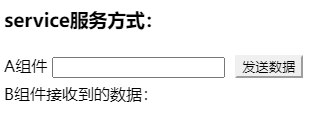
说明:示例中组件A和B都引入了同一个服务service,service服务则巧妙利用BehaviorSubject实现数据的发布和订阅,在两个组件中进行数据的通信,是不是没有想象的那么难~
路由传参方式
路由传参有多种方式,首先我们新建一个路由模块app-routing.module.ts,代码如下:
import { NgModule } from '@angular/core';
import { RouterModule, Routes } from '@angular/router';
import { AppComponent } from './app.component';
import { DetailComponent } from './detail/detail.component';
// 配置路由
const routes: Routes = [
{ path: 'detail', component: DetailComponent },
{ path: 'detail/:id', component: DetailComponent },
];
@NgModule({
imports: [RouterModule.forRoot(routes)],
exports: [RouterModule],
})
export class AppRoutingModule {}
引入路由相关的RouterModule和Routes,引入跳转文章详情组件DetailComponent,配置好路由routes,当路径为detail或detail/:id时,会加载DetailComponent组件,其中:id为占位符,可以在组件ts文件中获取id值。
创建好路由模块我们还需要在根模块app.module.ts中导入。
import { AppRoutingModule } from './app-routing.module';
@NgModule({
declarations: [...],
imports: [AppRoutingModule],
providers: [DataService],
bootstrap: [AppComponent],
})
export class AppModule {}
在app.component.html文件中添加<router-outlet></router-outlet>路由占位符,Angular框架会根据当前的路由器状态将不同组件动态填充它。
配置完路由准备工作,我们来具体看下有哪些路由传参方式。
路由路径传参
路由路径中传参,链接形式为:https://ip/detail/1。
在app.component.html中使用路由指令routerLink的方式在路由路径中传参。
<a [routerLink]="['/detail',1]">
1.文章1(路由路径中传参,链接:https://ip/detail/1)
</a>
在detail组件detail.component.ts中使用当前路由对象ActivatedRoute获取路由传递的参数。
import { Component, OnInit } from '@angular/core';
import { ActivatedRoute, Params } from '@angular/router';
@Component({
selector: 'app-detail',
templateUrl: './detail.component.html',
})
export class DetailComponent implements OnInit {
id: any;
constructor(private routeInfo: ActivatedRoute) {}
ngOnInit() {
// 获取路由参数方法
this.routeInfo.params.subscribe((params: Params) => {
this.id = params['id'];
});
}
}
查询参数传参
查询参数中传参,链接形式为:https://ip/detail?id=2。
在app.component.html中同样使用路由指令routerLink,在queryParams查询参数中传递数据。
<a [routerLink]="['/detail']" [queryParams]="{ id: 2 }">
2. 文章2(查询参数中传参,链接:https://ip/detail?id=2)
</a>
在detail组件detail.component.ts中使用当前路由对象ActivatedRoute获取路由传递的参数。
import { Component, OnInit } from '@angular/core';
import { ActivatedRoute, Params } from '@angular/router';
@Component({
selector: 'app-detail',
templateUrl: './detail.component.html',
})
export class DetailComponent implements OnInit {
id: any;
constructor(private routeInfo: ActivatedRoute) {}
ngOnInit() {
// 获取路由参数方法(params改为queryParams)
this.routeInfo.queryParams.subscribe((params: Params) => {
this.id = params['id'];
});
}
}
仔细观察会发现,第一种路由路径中传参使用的是this.routeInfo.queryParams获取数据,而第二种查询参数中传参使用的是this.routeInfo.queryParams,一定要注意这个区别。
路由配置传参
除了在app.component.html中使用路由指令routerLink,我们还可以在app.component.ts文件中通过路由配置中传参。
在app.component.html文件中绑定两个点击方法toArticle3()和toArticle4()。
<a (click)="toArticle3()">
3. 文章3(路由配置中传参,链接:https://ip/detail/3)</a>
<a (click)="toArticle4()">
4. 文章4(路由配置中传参,链接:https://ip/detail?id=4)</a>
在app.component.ts文件中通过路由Router的navigate()方法实现跳转。
import { Component } from '@angular/core';
import { Router } from '@angular/router';
@Component({
selector: 'app-root',
templateUrl: './app.component.html',
styleUrls: ['./app.component.css'],
})
export class AppComponent {
constructor(private router: Router) {}
toArticle3() {
// 路由跳转文章3
this.router.navigate(['/detail', 3]);
}
toArticle4() {
// 路由跳转文章4
this.router.navigate(['/detail'], { queryParams: { id: 4 } });
}
}
虽然是通过路由配置传参跳转,但我们仍然可以发现,文章3和文章1的跳转链接一致,文章4和文章2的跳转链接一致,本质上也是路由路径传参和查询参数传参。所以在detail.component.ts中,接收路由参数的方法是一致的。
import { Component, OnInit } from '@angular/core';
import { ActivatedRoute, Params } from '@angular/router';
@Component({
selector: 'app-detail',
templateUrl: './detail.component.html',
})
export class DetailComponent implements OnInit {
id: any;
constructor(private routeInfo: ActivatedRoute) {}
ngOnInit() {
// 文章3路由参数获取(params)
this.routeInfo.params.subscribe((params: Params) => {
this.id = params['id'];
});
// 文章4路由参数获取(queryParams)
this.routeInfo.queryParams.subscribe((params: Params) => {
this.id = params['id'];
});
}
}
最终展示效果如下,您可以通过 在线示例 预览效果和编辑调试:

这里需要说明下,在线示例中点击文章url并未发生改变,这是因为stackblitz工具机制的问题,你可以点击在线示例界面的Open in New Tab按钮,在单独页面打开可规避该问题。
延伸:示例中的获取路由参数都是使用subscribe参数订阅的方式,还有一种snapshot参数快照的方式。如获取文章1路由参数写法为:this.id = this.routeInfo.snapshot.params['id'];,获取文章2路由参数写法为:this.id = this.routeInfo.snapshot.queryParams['id'];,可以看到同样是params与queryParams的区别。
snapshot参数快照和subscribe参数订阅两者的区别在于,当路由地址不变的情况下,若参数变化,snapshot参数快照获取的参数值不变,subscribe参数订阅获取的参数值会变化。
我们使用snapshot参数快照测试一下文章1和文章3,效果如下:
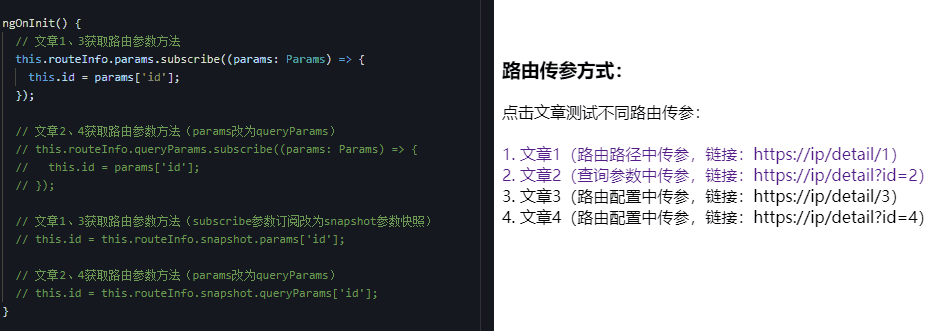
那么snapshot参数快照获取的参数为什么不发生变化了呢?这是由于第一次点击文章1跳转detail组件,constructor()和ngOnInit()会被调用一次,再次点击文章3,由于detail组件页面已经被创建了,ngOnInit()方法不会再次被调用,所以路由参数id依然保存着第一次被创建时候的值1。
LocalStorage方式
当然你也可以使用本地存储这种比较通用的方式在组件间通信。
创建C组件c.component.ts将数据存储到key为cValue的localStorage中,代码如下:
import { Component } from '@angular/core';
@Component({
selector: 'app-c',
templateUrl: './c.component.html',
})
export class CComponent {
constructor() {}
inputValue: string = '';
send(): void {
// 存储数据
window.localStorage.setItem('cValue', this.inputValue);
}
}
创建D组件d.component.ts获取localStorage中cValue的值。
import { Component } from '@angular/core';
@Component({
selector: 'app-d',
templateUrl: './d.component.html',
})
export class DComponent {
data: any;
constructor() {}
getValue() {
// 获取数据
this.data = window.localStorage.getItem('cValue');
}
}
最终展示效果如下,您可以通过 在线示例 预览效果和编辑调试:
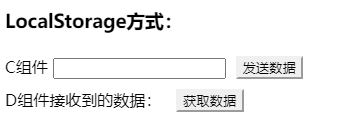
注:这里没有使用sessionStorage存储是因为localStorage生命周期是永久的,而sessionStorage生命周期仅为当前标签页,如果两个组件分别在两个标签页,那么使用sessionStorage是无法实现通信的。
服务端通信方式
最后一种通信方式是借助后台传输数据,如A组件调接口发送数据data存储到后台,再由B组件调接口获取数据data,实现数据通信,这里就不做演示了。
总结
Angular组件间的通信方式是多种多样的,对于不同情景我们可以采用合适的方式进行通信。
本文每个示例的重点我都有详细的说明,并延展一些相关知识。示例都是我自己一点点亲手敲的,从0到1研究示例实现方案,虽然花费了很长时间,但加深巩固了知识,之前忽略的一些知识细节也得到了补充,建议大家在学习的同时最好也能动手实现。
好啦,以上就是Angular组件间各种通信方式的所有内容,希望对你有所帮助,如有问题可通过我的博客https://echeverra.cn或微信公众号echeverra联系我。
你学“废”了么?
(完)
文章首发于我的博客 https://echeverra.cn/component-communication,原创文章,转载请注明出处。
欢迎关注我的微信公众号 echeverra,一起学习进步!不定时会有资源和福利相送哦!